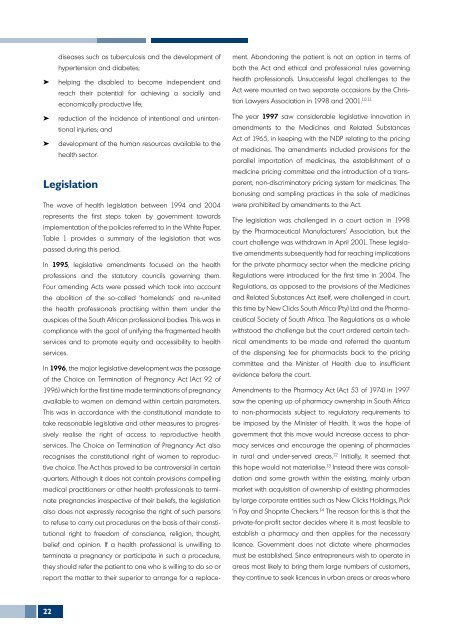SAHR 2007 - Health Systems Trust
SAHR 2007 - Health Systems Trust
SAHR 2007 - Health Systems Trust
Create successful ePaper yourself
Turn your PDF publications into a flip-book with our unique Google optimized e-Paper software.
diseases such as tuberculosis and the development of<br />
hypertension and diabetes;<br />
➤ helping the disabled to become independent and<br />
reach their potential for achieving a socially and<br />
economically productive life;<br />
➤ reduction of the incidence of intentional and unintentional<br />
injuries; and<br />
➤ development of the human resources available to the<br />
health sector.<br />
Legislation<br />
The wave of health legislation between 1994 and 2004<br />
represents the first steps taken by government towards<br />
implementation of the policies referred to in the White Paper.<br />
Table 1 provides a summary of the legislation that was<br />
passed during this period.<br />
In 1995, legislative amendments focused on the health<br />
professions and the statutory councils governing them.<br />
Four amending Acts were passed which took into account<br />
the abolition of the so-called ‘homelands’ and re-united<br />
the health professionals practising within them under the<br />
auspices of the South African professional bodies. This was in<br />
compliance with the goal of unifying the fragmented health<br />
services and to promote equity and accessibility to health<br />
services.<br />
In 1996, the major legislative development was the passage<br />
of the Choice on Termination of Pregnancy Act (Act 92 of<br />
1996) which for the first time made terminations of pregnancy<br />
available to women on demand within certain parameters.<br />
This was in accordance with the constitutional mandate to<br />
take reasonable legislative and other measures to progressively<br />
realise the right of access to reproductive health<br />
services. The Choice on Termination of Pregnancy Act also<br />
recognises the constitutional right of women to reproductive<br />
choice. The Act has proved to be controversial in certain<br />
quarters. Although it does not contain provisions compelling<br />
medical practitioners or other health professionals to terminate<br />
pregnancies irrespective of their beliefs, the legislation<br />
also does not expressly recognise the right of such persons<br />
to refuse to carry out procedures on the basis of their constitutional<br />
right to freedom of conscience, religion, thought,<br />
belief and opinion. If a health professional is unwilling to<br />
terminate a pregnancy or participate in such a procedure,<br />
they should refer the patient to one who is willing to do so or<br />
report the matter to their superior to arrange for a replacement.<br />
Abandoning the patient is not an option in terms of<br />
both the Act and ethical and professional rules governing<br />
health professionals. Unsuccessful legal challenges to the<br />
Act were mounted on two separate occasions by the Christian<br />
Lawyers Association in 1998 and 2001. 10,11<br />
The year 1997 saw considerable legislative innovation in<br />
amendments to the Medicines and Related Substances<br />
Act of 1965, in keeping with the NDP relating to the pricing<br />
of medicines. The amendments included provisions for the<br />
parallel importation of medicines, the establishment of a<br />
medicine pricing committee and the introduction of a transparent,<br />
non-discriminatory pricing system for medicines. The<br />
bonusing and sampling practices in the sale of medicines<br />
were prohibited by amendments to the Act.<br />
The legislation was challenged in a court action in 1998<br />
by the Pharmaceutical Manufacturers’ Association, but the<br />
court challenge was withdrawn in April 2001. These legislative<br />
amendments subsequently had far reaching implications<br />
for the private pharmacy sector when the medicine pricing<br />
Regulations were introduced for the first time in 2004. The<br />
Regulations, as opposed to the provisions of the Medicines<br />
and Related Substances Act itself, were challenged in court,<br />
this time by New Clicks South Africa (Pty) Ltd and the Pharmaceutical<br />
Society of South Africa. The Regulations as a whole<br />
withstood the challenge but the court ordered certain technical<br />
amendments to be made and referred the quantum<br />
of the dispensing fee for pharmacists back to the pricing<br />
committee and the Minister of <strong>Health</strong> due to insufficient<br />
evidence before the court.<br />
Amendments to the Pharmacy Act (Act 53 of 1974) in 1997<br />
saw the opening up of pharmacy ownership in South Africa<br />
to non-pharmacists subject to regulatory requirements to<br />
be imposed by the Minister of <strong>Health</strong>. It was the hope of<br />
government that this move would increase access to pharmacy<br />
services and encourage the opening of pharmacies<br />
in rural and under-served areas. 12 Initially, it seemed that<br />
this hope would not materialise. 13 Instead there was consolidation<br />
and some growth within the existing, mainly urban<br />
market with acquisition of ownership of existing pharmacies<br />
by large corporate entities such as New Clicks Holdings, Pick<br />
’n Pay and Shoprite Checkers. 14 The reason for this is that the<br />
private-for-profit sector decides where it is most feasible to<br />
establish a pharmacy and then applies for the necessary<br />
licence. Government does not dictate where pharmacies<br />
must be established. Since entrepreneurs wish to operate in<br />
areas most likely to bring them large numbers of customers,<br />
they continue to seek licences in urban areas or areas where<br />
22
















